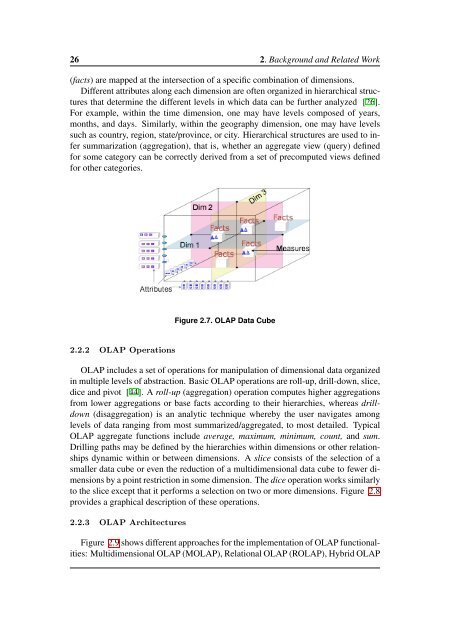Applying OLAP Pre-Aggregation Techniques to ... - Jacobs University
Applying OLAP Pre-Aggregation Techniques to ... - Jacobs University
Applying OLAP Pre-Aggregation Techniques to ... - Jacobs University
Create successful ePaper yourself
Turn your PDF publications into a flip-book with our unique Google optimized e-Paper software.
26 2. Background and Related Work<br />
(facts) are mapped at the intersection of a specific combination of dimensions.<br />
Different attributes along each dimension are often organized in hierarchical structures<br />
that determine the different levels in which data can be further analyzed [26].<br />
For example, within the time dimension, one may have levels composed of years,<br />
months, and days. Similarly, within the geography dimension, one may have levels<br />
such as country, region, state/province, or city. Hierarchical structures are used <strong>to</strong> infer<br />
summarization (aggregation), that is, whether an aggregate view (query) defined<br />
for some category can be correctly derived from a set of precomputed views defined<br />
for other categories.<br />
Figure 2.7. <strong>OLAP</strong> Data Cube<br />
2.2.2 <strong>OLAP</strong> Operations<br />
<strong>OLAP</strong> includes a set of operations for manipulation of dimensional data organized<br />
in multiple levels of abstraction. Basic <strong>OLAP</strong> operations are roll-up, drill-down, slice,<br />
dice and pivot [44]. A roll-up (aggregation) operation computes higher aggregations<br />
from lower aggregations or base facts according <strong>to</strong> their hierarchies, whereas drilldown<br />
(disaggregation) is an analytic technique whereby the user navigates among<br />
levels of data ranging from most summarized/aggregated, <strong>to</strong> most detailed. Typical<br />
<strong>OLAP</strong> aggregate functions include average, maximum, minimum, count, and sum.<br />
Drilling paths may be defined by the hierarchies within dimensions or other relationships<br />
dynamic within or between dimensions. A slice consists of the selection of a<br />
smaller data cube or even the reduction of a multidimensional data cube <strong>to</strong> fewer dimensions<br />
by a point restriction in some dimension. The dice operation works similarly<br />
<strong>to</strong> the slice except that it performs a selection on two or more dimensions. Figure 2.8<br />
provides a graphical description of these operations.<br />
2.2.3 <strong>OLAP</strong> Architectures<br />
Figure 2.9 shows different approaches for the implementation of <strong>OLAP</strong> functionalities:<br />
Multidimensional <strong>OLAP</strong> (M<strong>OLAP</strong>), Relational <strong>OLAP</strong> (R<strong>OLAP</strong>), Hybrid <strong>OLAP</strong>
















